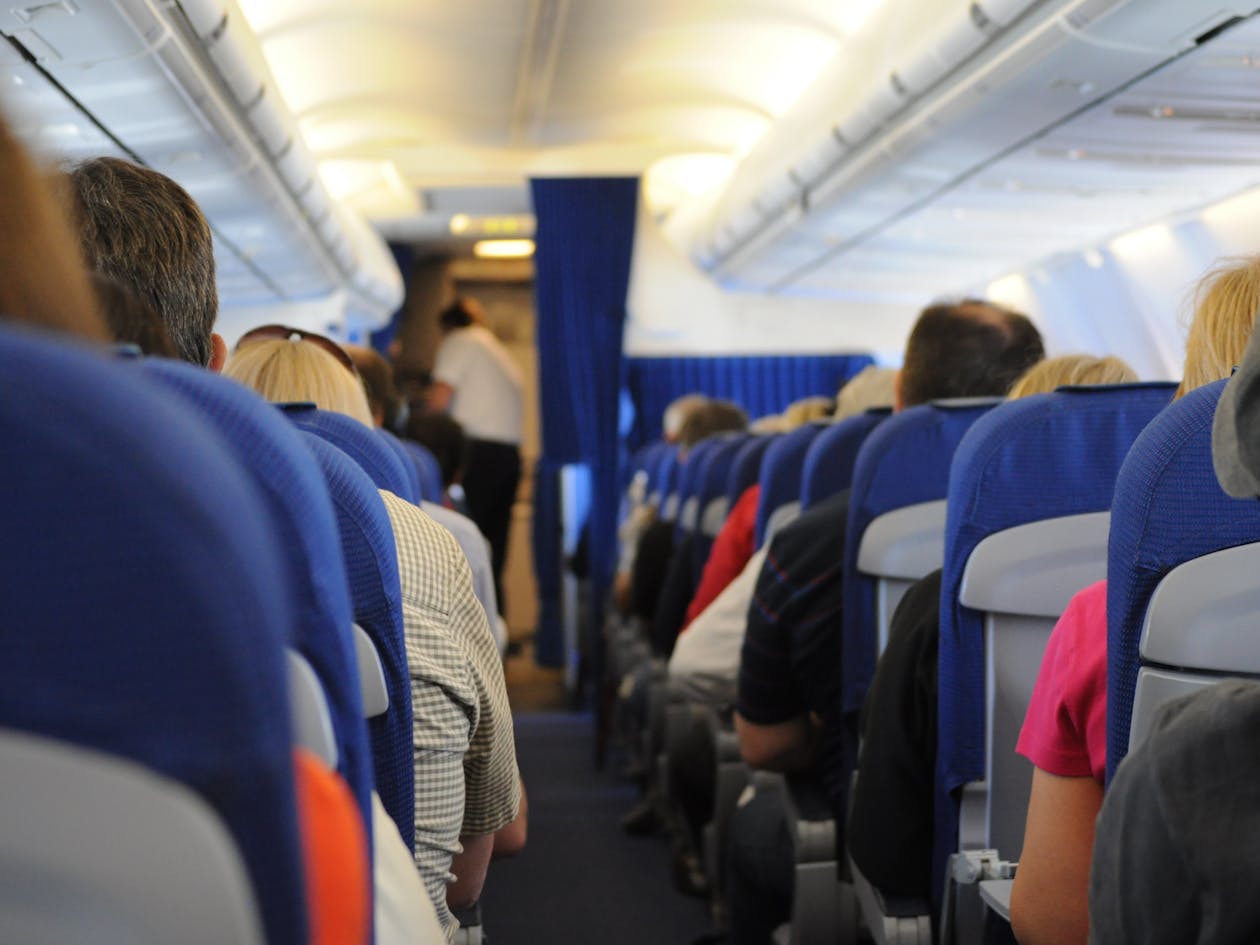A woman sits peacefully in her airplane seat, 30,000 feet above the ground, when she feels a sharp pain. Someone has just stabbed her with a metal fork. Her attacker? A small child wanders the aisles while her mother sleeps nearby. What happens next will divide millions of viewers and reignite the age-old debate about children on planes.
Footage of this Qatar Airways incident has gone viral across TikTok, capturing a moment that every frequent flyer secretly dreads. As the stabbed passenger reaches for her sandal in frustration, threatening retaliation against a child, viewers find themselves picking sides in a battle that has no clear winners. Some see an exhausted parent pushed to her limits on a 14-hour flight. Others see a passenger whose personal space and safety were violated by someone else’s parenting choices.
Behind the viral moment lies a deeper truth about modern air travel: we’re all crammed into metal tubes for hours on end, forced to share space with strangers whose ideas about acceptable behavior might be worlds apart from our own. When those strangers include unsupervised children armed with utensils, tensions can escalate quickly.
The Fork Incident That Broke the Internet
Everything started when a young girl began roaming the Qatar Airlines cabin during a grueling 14-hour flight. Her mother had dozed off in her seat, leaving the child to explore on her own. Armed with a metal fork from the meal service, the girl approached random passengers with unpredictable results.
“She’s over here stabbing people with forks. She just randomly stabbed me with a fork,” the victim told flight attendants, her voice a mixture of disbelief and anger. Video footage shows her sister frantically flagging down cabin crew while the situation spirals out of control.
Flight attendants rushed to intervene, reaching for the fork in the child’s hand while another crew member woke the sleeping mother. But by then, the stabbed passenger had reached her breaking point. Holding up her sandal like a weapon, she made her intentions clear: “I’m gonna fk her up… I’m going to smack the st out of her.”
Behind the camera, the woman filming couldn’t suppress her giggles as she watched the drama unfold. Her amusement would later become another flashpoint in the online debate, with viewers questioning why anyone would find the situation funny. Meanwhile, the newly awakened mother seemed bewildered by the chaos her child had created during her brief rest.
Why Parents Struggle on Long-Haul Flights
Fourteen hours in an airplane with a young child tests even the most dedicated parent. Sleep deprivation clouds judgment. Exhaustion weakens resolve. Every parent who has attempted a long-haul flight knows the unique torture of trying to keep a small human entertained, quiet, and seated for hours that feel like days.
Consider what leads to that moment of surrender when a parent closes their eyes, just for a minute. Maybe the child has been crying for hours. Perhaps they’ve already burned through every snack, toy, and downloaded cartoon. The parent might be traveling alone, without another adult to share the burden. International flights often mean crossing multiple time zones, throwing off everyone’s sleep schedule and turning day into night.
None of these excuses justify leaving a child to wander unsupervised with a weapon, even a small one. But understanding the circumstances helps explain how these situations develop. Parents don’t board planes intending to let their children terrorize other passengers. They are hoping to survive the journey with everyone’s sanity intact.
Airlines provide minimal support for families beyond basic safety equipment. Parents must anticipate every need, pack every entertainment option, and somehow maintain control in an environment that makes children restless and irritable. When exhaustion prevails, as it did in this mother’s case, the results can be catastrophic for everyone involved.
When Fellow Passengers Reach Their Breaking Point

Being stabbed with a fork by a stranger’s child would test anyone’s patience. Add the stress of a long flight, and it’s remarkable the passenger didn’t react more strongly. Her threat to hit the child with her sandal shocked some viewers, but others saw it as an understandable response to an unprecedented situation.
Passengers pay hundreds or thousands of dollars for their seats. They expect basic safety and comfort, not random attacks from unsupervised children. Many travelers plan their flights carefully, choosing seats away from families or paying extra for premium cabins to avoid these exact scenarios. When a child with a fork shatters that illusion of control, frustration naturally follows.
Air travel already pushes people to their limits. Cramped seats, recycled air, delays, and constant proximity to strangers create a pressure cooker environment. Most passengers maintain civility through an unspoken social contract: we’ll all suffer together if everyone follows the rules. An uncontrolled child with a weapon breaks that contract entirely.
Yet threatening violence against a child crosses another line entirely. Adults bear responsibility for managing their reactions, regardless of provocation. Many viewers pointed out that the passenger had options beyond grabbing her shoe, such as calling for help sooner, moving seats, or simply taking the fork away herself. Her extreme reaction reveals how quickly airplane conflicts can escalate when multiple people reach their breaking points simultaneously.
Flight Attendants Caught in the Middle
Cabin crew members undergo extensive training for medical emergencies, security threats, and passenger conflicts. Nowhere in their manual is there likely a chapter on disarming fork-wielding toddlers while mediating between angry adults. Yet these situations land squarely in their laps, requiring diplomatic skills that would challenge seasoned negotiators.
Flight attendants must balance multiple competing interests. They need to ensure passenger safety while avoiding actions that could escalate tensions. They must maintain professional composure while dealing with behavior that would be unacceptable in any other workplace. They serve as referees, counselors, and enforcement officers, often simultaneously.
In this incident, the crew acted swiftly once alerted. One attendant secured the fork while another woke the mother. But their options for preventing such incidents remain limited. They can’t monitor every child or supervise every parent. They can’t refuse service to families who might struggle with control. They can’t create separate sections for passengers who prefer child-free flights.
Airlines put their crews in impossible positions, expecting them to manage situations that reflect broader societal disagreements about children in public spaces. Flight attendants become the face of policies they didn’t create, dealing with frustrated passengers who see them as either enablers or enforcers, depending on their perspective.
The Social Media Jury Weighs In

Within hours of posting, the TikTok video had garnered thousands of comments, each side taking a stance in the conflict. “Y’all laughing but this is not okay,” one viewer wrote, disturbed by the filmer’s apparent amusement. Others focused on defending the child: “It’s only a child for crying out loud!”
Commentary quickly evolved beyond the specific incident to broader questions about modern parenting. “Where’s the parent? Who lets their kid just randomly bother people?” became a common refrain. Others offered more pointed criticism: “Some parents don’t understand that not everyone thinks their child is cute.”
Humor crept into the discussion too, with one commenter writing, “Not you grabbing your slipper like she was a roach.” But beneath the jokes lay serious disagreements about responsibility, boundaries, and acceptable responses to children’s behavior in public spaces.
Social media amplifies these conflicts by removing nuance and context. Viewers judge split-second decisions from the comfort of their homes, without experiencing the exhaustion, frustration, or fear that influenced those choices. The video becomes a Rorschach test, revealing more about viewers’ attitudes toward parenting and personal space than about the incident itself.
Unspoken Rules of Flying with Children
Every experienced traveler knows the unwritten rules of airplane etiquette. Don’t recline during meal service. Use headphones for entertainment. Keep personal items contained. However, when children enter the equation, these rules become both more important and more difficult to enforce.
Parents bear primary responsibility for their children’s behavior, including securing potential weapons, such as metal forks. Basic preparation should include entertainment options, snacks, and strategies for managing restlessness. Allowing a child to wander unsupervised violates the fundamental trust between passengers sharing a confined space.
“Her mumma didn’t do nothing. At this point we feel like the mum was probably tired and definitely wanted someone else to watch her kids,” the woman who filmed the incident later explained. This observation hits at a core tension: parental exhaustion doesn’t transfer responsibility to other passengers or crew members.
Yet the village mentality that once helped parents manage children in public has largely disappeared. Fellow passengers feel no obligation to assist or show patience. Flight attendants can’t serve as babysitters. Parents are increasingly isolated, managing impossible situations without support systems that previous generations took for granted.
Finding Solutions at 30,000 Feet

Airlines could take concrete steps to prevent these incidents. Family-friendly sections with age-appropriate entertainment and trained staff could provide buffer zones between families and other passengers, allowing for a more enjoyable experience. Some international carriers have already experimented with child-free zones, although this remains controversial in markets that view such policies as discriminatory.
Better support for parents might include airline-provided entertainment tablets, child-safe meal service without dangerous utensils, and flight attendants trained specifically in family travel challenges. Even simple changes, such as boarding families last rather than first, could reduce the time children spend confined before takeoff.
Passengers also need realistic expectations. Choosing to fly means accepting the presence of other humans, including small, unpredictable ones. While no one should tolerate being stabbed with a fork, most child-related disruptions fall far short of physical assault. Building tolerance and empathy into travel expectations could prevent many conflicts from escalating.
Technology offers promising solutions, too. Noise-canceling headphones help passengers create personal bubbles. Entertainment systems with parental controls keep children engaged. Some airlines are experimenting with virtual reality headsets that could transform the way we experience long flights, potentially making the presence of others less intrusive.
Learning from the Chaos

One child, one fork, one exhausted mother, and one frustrated passenger created a viral moment that speaks to larger truths about modern air travel. We share intimate space with strangers for hours, bringing our different values, expectations, and tolerance levels into unavoidable conflict.
This incident reveals the cracks in our system: overwhelmed parents without support, passengers with no recourse for disruption, and flight crews expected to manage the unmanageable. Nobody wins when a child stabs strangers with forks while their parent sleeps. But everybody loses when we respond without compassion or understanding.
Until systemic changes arrive, we’re left with individual choices. We can film conflicts for social media fame or offer help before situations escalate. We can judge harshly or remember our moments of desperation. We can grab our shoes in anger or recognize that sometimes, even the best parents and passengers reach their limits. Ultimately, we’re all just trying to get to our destinations with our dignity intact.













Leave a Reply